A Novel Nanofiber Hydrogel Adhesive Based on Carboxymethyl Cellulose Modified by Adenine and Thymine
Abstract
1. Introduction
2. Materials and Methods
2.1. Experimental Materials
2.2. Preparation of CMC-AT Nanofiber Hydrogel Adhesive
2.3. Characterizations
2.4. Shear Adhesion Test
3. Results and Discussion
3.1. Morphological Characterization
3.2. Fourier Transform Infrared Spectroscopy Analysis
3.3. Solid-State Nuclear Magnetic Resonance Analysis
3.4. X-ray Diffraction Analysis
3.5. Tensile Strength Test
3.6. Adhesion Condition of Wood Surface
3.7. Shear Adhesion Strength Test
4. Conclusions
Author Contributions
Funding
Institutional Review Board Statement
Data Availability Statement
Acknowledgments
Conflicts of Interest
References
- Li, A.; Jia, Y.; Sun, S.; Xu, Y.; Minsky, B.B.; Stuart, M.A.C.; Cölfen, H.; von Klitzing, R.; Guo, X. Mineral-Enhanced Polyacrylic Acid Hydrogel as an Oyster-Inspired Organic–Inorganic Hybrid Adhesive. ACS Appl. Mater. Interfaces 2018, 10, 10471–10479. [Google Scholar] [CrossRef]
- Wang, J.; Zhang, N.; Tan, Y.; Fu, F.; Liu, G.; Fang, Y.; Zhang, X.-X.; Liu, M.; Cheng, Y.; Yu, J. Sweat-Resistant Silk Fibroin-Based Double Network Hydrogel Adhesives. ACS Appl. Mater. Interfaces 2022, 14, 21945–21953. [Google Scholar] [CrossRef]
- Yuk, H.; Varela, C.E.; Nabzdyk, C.S.; Mao, X.; Padera, R.F.; Roche, E.T.; Zhao, X. Dry double-sided tape for adhesion of wet tissues and devices. Nature 2019, 575, 169–174. [Google Scholar] [CrossRef] [PubMed]
- Oelker, A.M.; Berlin, J.A.; Wathier, M.; Grinstaff, M.W. Synthesis and Characterization of Dendron Cross-Linked PEG Hydrogels as Corneal Adhesives. Biomacromolecules 2011, 12, 1658–1665. [Google Scholar] [CrossRef] [PubMed]
- Choi, Y.; Kang, K.; Son, D.; Shin, M. Molecular Rationale for the Design of Instantaneous, Strain-Tolerant Polymeric Adhesive in a Stretchable Underwater Human–Machine Interface. ACS Nano 2022, 16, 1368–1380. [Google Scholar] [CrossRef] [PubMed]
- Yuan, J.; Du, G.; Yang, H.; Liu, S.; Wu, Y.; Ni, K.; Ran, X.; Gao, W.; Yang, L.; Li, J. Functionalization of cellulose with amine group and cross-linked with branched epoxy to construct high-performance wood adhesive. Int. J. Biol. Macromol. 2022, 222, 2719–2728. [Google Scholar] [CrossRef] [PubMed]
- Cai, L.; Chen, Y.; Lu, Z.; Wei, M.; Zhao, X.; Xie, Y.; Li, J.; Xiao, S. Citric acid/chitosan adhesive with viscosity-controlled for wood bonding through supramolecular self-assembly. Carbohydr. Polym. 2024, 329, 121765. [Google Scholar] [CrossRef] [PubMed]
- Luotonen, O.I.; Greca, L.G.; Nyström, G.; Guo, J.; Richardson, J.J.; Rojas, O.J.; Tardy, B.L. Benchmarking supramolecular adhesive behavior of nanocelluloses, cellulose derivatives and proteins. Carbohydr. Polym. 2022, 292, 119681. [Google Scholar] [CrossRef] [PubMed]
- Liu, S.; Du, G.; Yang, H.; Su, H.; Ran, X.; Li, J.; Zhang, L.; Gao, W.; Yang, L. Developing High-Performance Cellulose-Based Wood Adhesive with a Cross-Linked Network. ACS Sustain. Chem. Eng. 2021, 9, 16849–16861. [Google Scholar] [CrossRef]
- Wang, J.; Qi, F.; Feng, H.; Xu, A.; Lu, D.-Q.; Liang, J.; Zhang, Z.; Li, J.; Liu, D.; Zhang, B.; et al. In situ formed tissue-adhesive carboxymethyl chitosan hydrogels through photoclick chemistry for wound healing. Eur. Polym. J. 2024, 203, 112680. [Google Scholar] [CrossRef]
- Zhao, D.; Zhu, Y.; Cheng, W.; Xu, G.; Wang, Q.; Liu, S.; Li, J.; Chen, C.; Yu, H.; Hu, L. A Dynamic Gel with Reversible and Tunable Topological Networks and Performances. Matter 2019, 2, 390–403. [Google Scholar] [CrossRef]
- Rahman, M.S.; Hasan, M.S.; Nitai, A.S.; Nam, S.; Karmakar, A.K.; Ahsan, M.S.; Shiddiky, M.J.A.; Ahmed, M.B. Recent Developments of Carboxymethyl Cellulose. Polymers 2021, 13, 1345. [Google Scholar] [CrossRef] [PubMed]
- Tyagi, V.; Thakur, A. Applications of biodegradable carboxymethyl cellulose-based composites. Results Mater. 2023, 20, 100481. [Google Scholar] [CrossRef]
- Lee, H.; Yoo, B. Agglomerated xanthan gum powder used as a food thickener: Effect of sugar binders on physical, microstructural, and rheological properties. Powder Technol. 2019, 362, 301–306. [Google Scholar] [CrossRef]
- An, F.; Fang, K.; Liu, X.; Li, C.; Liang, Y.; Liu, H. Rheological properties of carboxymethyl hydroxypropyl cellulose and its application in high quality reactive dye inkjet printing on wool fabrics. Int. J. Biol. Macromol. 2020, 164, 4173–4182. [Google Scholar] [CrossRef] [PubMed]
- Promphet, N.; Rattanawaleedirojn, P.; Siralertmukul, K.; Soatthiyanon, N.; Potiyaraj, P.; Thanawattano, C.; Hinestroza, J.P.; Rodthongkum, N. Non-invasive textile based colorimetric sensor for the simultaneous detection of sweat pH and lactate. Talanta 2018, 192, 424–430. [Google Scholar] [CrossRef] [PubMed]
- Kalmer, R.R.; Mohammadi, M.; Karimi, A.; Najafpour, G.; Haghighatnia, Y. Fabrication and evaluation of carboxymethylated diethylaminoethyl cellulose microcarriers as support for cellular applications. Carbohydr. Polym. 2019, 226, 115284. [Google Scholar] [CrossRef] [PubMed]
- Jantrawut, P.; Bunrueangtha, J.; Suerthong, J.; Kantrong, N. Fabrication and Characterization of Low Methoxyl Pectin/Gelatin/Carboxymethyl Cellulose Absorbent Hydrogel Film for Wound Dressing Applications. Materials 2019, 12, 1628. [Google Scholar] [CrossRef]
- Cheng, Y.; Ren, X.; Duan, L.; Gao, G. A transparent and adhesive carboxymethyl cellulose/polypyrrole hydrogel electrode for flexible supercapacitors. J. Mater. Chem. C 2020, 8, 8234–8242. [Google Scholar] [CrossRef]
- Dong, S.; Feng, S.; Liu, F.; Li, R.; Li, W.; Liu, F.; Shi, G.; Chen, L.; Zhang, Y. Factors influencing the adhesive behavior of carboxymethyl cellulose-based hydrogel for food applications. Int. J. Biol. Macromol. 2021, 179, 398–406. [Google Scholar] [CrossRef]
- Enoch, K.; Somasundaram, A.A. Rheological insights on Carboxymethyl cellulose hydrogels. Int. J. Biol. Macromol. 2023, 253, 127481. [Google Scholar] [CrossRef] [PubMed]
- Kong, D.; Zhang, Q.; You, J.; Cheng, Y.; Hong, C.; Chen, Z.; Jiang, T.; Hao, T. Adhesion loss mechanism based on carboxymethyl cellulose-filled hydrocolloid dressings in physiological wounds environment. Carbohydr. Polym. 2020, 235, 115953. [Google Scholar] [CrossRef] [PubMed]
- Bian, S.; Chen, Y.; Huang, X.; Guo, Y.; Xiao, H.; Zhang, M.; Liu, K.; Huang, L.; Chen, L.; Wu, H. A catechol-containing dialdehyde cellulose adhesive with strong adhesion and biocompatibility. React. Funct. Polym. 2023, 185, 105542. [Google Scholar] [CrossRef]
- Yao, K.; Li, S.; Zheng, X.; Zhang, Q.; Liu, J.; Liang, C.; Duan, K.; Ye, J.; Yin, Y.; Chen, X. Superwettable calcium ion exchanged carboxymethyl cellulose powder with self-gelation, tissue adhesion and bioabsorption for effective hemorrhage control. Chem. Eng. J. 2024, 481, 148770. [Google Scholar] [CrossRef]
- Kumar, B.; Kumar, S.; Kim, J. Novel carboxymethyl cellulose-grafted polyacrylic acid/cellulose nanocrystal nanocomposite materials as bio-based adhesive. Mater. Today Commun. 2024, 38, 108497. [Google Scholar] [CrossRef]
- Feng, S.; Liu, F.; Guo, Y.; Ye, M.; He, J.; Zhou, H.; Liu, L.; Cai, L.; Zhang, Y.; Li, R. Exploring the role of chitosan in affecting the adhesive, rheological and antimicrobial properties of carboxymethyl cellulose composite hydrogels. Int. J. Biol. Macromol. 2021, 190, 554–563. [Google Scholar] [CrossRef]
- Tang, Z.; Miao, Y.; Zhao, J.; Xiao, H.; Zhang, M.; Liu, K.; Zhang, X.; Huang, L.; Chen, L.; Wu, H. Mussel-inspired biocompatible polydopamine/carboxymethyl cellulose/polyacrylic acid adhesive hydrogels with UV-shielding capacity. Cellulose 2021, 28, 1527–1540. [Google Scholar] [CrossRef] [PubMed]
- Chen, Y.; Cui, G.; Dan, N.; Huang, Y.; Bai, Z.; Yang, C.; Dan, W. Preparation and characterization of dopamine–sodium carboxymethyl cellulose hydrogel. SN Appl. Sci. 2019, 1, 609. [Google Scholar] [CrossRef]
- Sekine, Y.; Nankawa, T.; Yunoki, S.; Sugita, T.; Nakagawa, H.; Yamada, T. Eco-friendly Carboxymethyl Cellulose Nanofiber Hydrogels Prepared via Freeze Cross-Linking and Their Applications. ACS Appl. Polym. Mater. 2020, 2, 5482–5491. [Google Scholar] [CrossRef]
- Hashmi, M.; Ullah, S.; Ullah, A.; Saito, Y.; Haider, K.; Bie, X.; Wada, K.; Kim, I.S. Carboxymethyl Cellulose (CMC) Based Electrospun Composite Nanofiber Mats for Food Packaging. Polymers 2021, 13, 302. [Google Scholar] [CrossRef]
- Park, J.S.; Lee, G.S.; Lee, Y.-J.; Park, Y.S.; Yoon, K.B. Organization of Microcrystals on Glass by Adenine−Thymine Hydrogen Bonding. J. Am. Chem. Soc. 2002, 124, 13366–13367. [Google Scholar] [CrossRef] [PubMed]
- Gardner, D.J.; Blumentritt, M.; Wang, L.; Yildirim, N. Adhesion Theories in Wood Adhesive Bonding. In Progress in Adhesion and Adhesives; Scrivener Publishing LLC.: Amsterdam, The Netherlands, 2015; pp. 125–168. [Google Scholar]
- Wang, Q.; Xiao, S.; Shi, S.Q.; Cai, L. The effect of delignification on the properties of cellulosic fiber material. Holzforschung 2018, 72, 443–449. [Google Scholar] [CrossRef]
- Lopez, C.G.; Rogers, S.E.; Colby, R.H.; Graham, P.; Cabral, J.T. Structure of sodium carboxymethyl cellulose aqueous solutions: A SANS and rheology study. J. Polym. Sci. Part B Polym. Phys. 2014, 53, 492–501. [Google Scholar] [CrossRef] [PubMed]
- Wilks, T.R.; O’Reilly, R.K. Efficient DNA–Polymer Coupling in Organic Solvents: A Survey of Amide Coupling, Thiol-Ene and Tetrazine–Norbornene Chemistries Applied to Conjugation of Poly(N-Isopropylacrylamide). Sci. Rep. 2016, 6, 39192. [Google Scholar] [CrossRef] [PubMed]
- Sun, H.; Martinez, D.; Li, Z.; Schanze, K.S. Biofunctionalization of Water-Soluble poly(Phenylene Ethynylene)s. ACS Appl. Mater. Interfaces 2020, 12, 53310–53317. [Google Scholar] [CrossRef] [PubMed]
- Liu, Z.; Zhang, H.; Sun, J.; Zheng, M.; Cui, L.; Zhang, Y.; Cheng, J.; Tang, Z.; Chen, X. Organic-Solvent-Free “Lego-Like” Modular Preparation of Fab-Nondestructive Antibody-Drug Conjugates with Ultrahigh Drug-to-Antibody Ratio. Adv. Mater. 2023, 35, 2300377. [Google Scholar] [CrossRef] [PubMed]
- Wu, P.-Y.; Shen, Z.-C.; Jiang, J.-L.; Zhang, B.-C.; Zhang, W.-Z.; Zou, J.-J.; Lin, J.-F.; Li, C.; Shao, J.-W. A multifunctional theranostics nanosystem featuring self-assembly of alcohol-abuse drug and photosensitizers for synergistic cancer therapy. Biomater. Sci. 2022, 10, 6267–6281. [Google Scholar] [CrossRef] [PubMed]
- Ding, P.; Wei, Q.; Tian, N.; Ding, X.; Wang, L.; Wang, B.; Okoro, O.V.; Shavandi, A.; Nie, L. Enzymatically crosslinked hydrogel based on tyramine modified gelatin and sialylated chitosan. Biomed. Mater. 2022, 18, 015006. [Google Scholar] [CrossRef] [PubMed]
- Mishra, M.K.; Kelley, S.P.; Smetana, V.; Dixon, D.A.; McNeill, A.S.; Mudring, A.-V.; Rogers, R.D. Crystallographic evidence of Watson–Crick connectivity in the base pair of anionic adenine with thymine. Proc. Natl. Acad. Sci. USA 2020, 117, 18224–18230. [Google Scholar] [CrossRef]
- Chandrasekhar, S.; Naik, T.R.R.; Nayak, S.K.; Row, T.N.G. Crystal structure of an intermolecular 2:1 complex between adenine and thymine. Evidence for both Hoogsteen and ‘quasi-Watson–Crick’ interactions. Bioorganic Med. Chem. Lett. 2010, 20, 3530–3533. [Google Scholar] [CrossRef]
- Etter, M.C.; Reutzel, S.M.; Choo, C.G. Self-organization of adenine and thymine in the solid state. J. Am. Chem. Soc. 1993, 115, 4411–4412. [Google Scholar] [CrossRef]
- Saladino, R.; Barontini, M.; Cossetti, C.; Di Mauro, E.; Crestini, C. The Effects of Borate Minerals on the Synthesis of Nucleic Acid Bases, Amino Acids and Biogenic Carboxylic Acids from Formamide. Space Life Sci. 2011, 41, 317–330. [Google Scholar] [CrossRef]
- Kobetić, R.; Kazazić, S.; Kovačević, B.; Glasovac, Z.; Krstulović, L.; Bajić, M.; Žinić, B. Mass Spectrometry and Theoretical Studies on N–C Bond Cleavages in the N-Sulfonylamidino Thymine Derivatives. J. Am. Soc. Mass Spectrom. 2015, 26, 833–842. [Google Scholar] [CrossRef] [PubMed]
- Sun, X.; Pang, Z.; Zhu, Y.; Yu, Z.; Yang, P.; Liu, L.; Renneckar, S.; Li, T.; Jiang, F. All-cellulose hydrogel-based adhesive. Innov. Mater. 2023, 1, 100040. [Google Scholar] [CrossRef]
- Yuan, J.; Du, G.; Yang, H.; Liu, S.; Park, S.; Liu, T.; Ran, X.; Park, B.; Gao, W.; Yang, L. Fully bio-based adhesive designed through lignin-cellulose combination and interfacial bonding reinforcement. Ind. Crop. Prod. 2023, 204, 117279. [Google Scholar] [CrossRef]
- Li, Z.; Gu, M.; Du, G.; Wang, J.; Liu, T.; Ni, K.; Yang, H.; Tan, X.; Ran, X.; Gao, W.; et al. Integration of Aromatic Polyurea and Dialdehyde Cellulose as High-Performance Hybrid Resin Adhesives for Bonding Wood. ACS Sustain. Chem. Eng. 2023, 11, 11878–11889. [Google Scholar] [CrossRef]
- Vineeth, S.K.; Gadhave, R.V.; Gadekar, P.T. Polyvinyl alcohol–cellulose blend wood adhesive modified by citric acid and its effect on physical, thermal, mechanical and performance properties. Polym. Bull. 2023, 80, 8013–8030. [Google Scholar] [CrossRef]
- Jiang, S.; Liu, S.; Du, G.; Wang, S.; Zhou, X.; Yang, J.; Shi, Z.; Yang, Z.; Li, T. Chitosan-tannin adhesive: Fully biomass, synthesis-free and high performance for bamboo-based composite bonding. Int. J. Biol. Macromol. 2023, 230, 123115. [Google Scholar] [CrossRef]
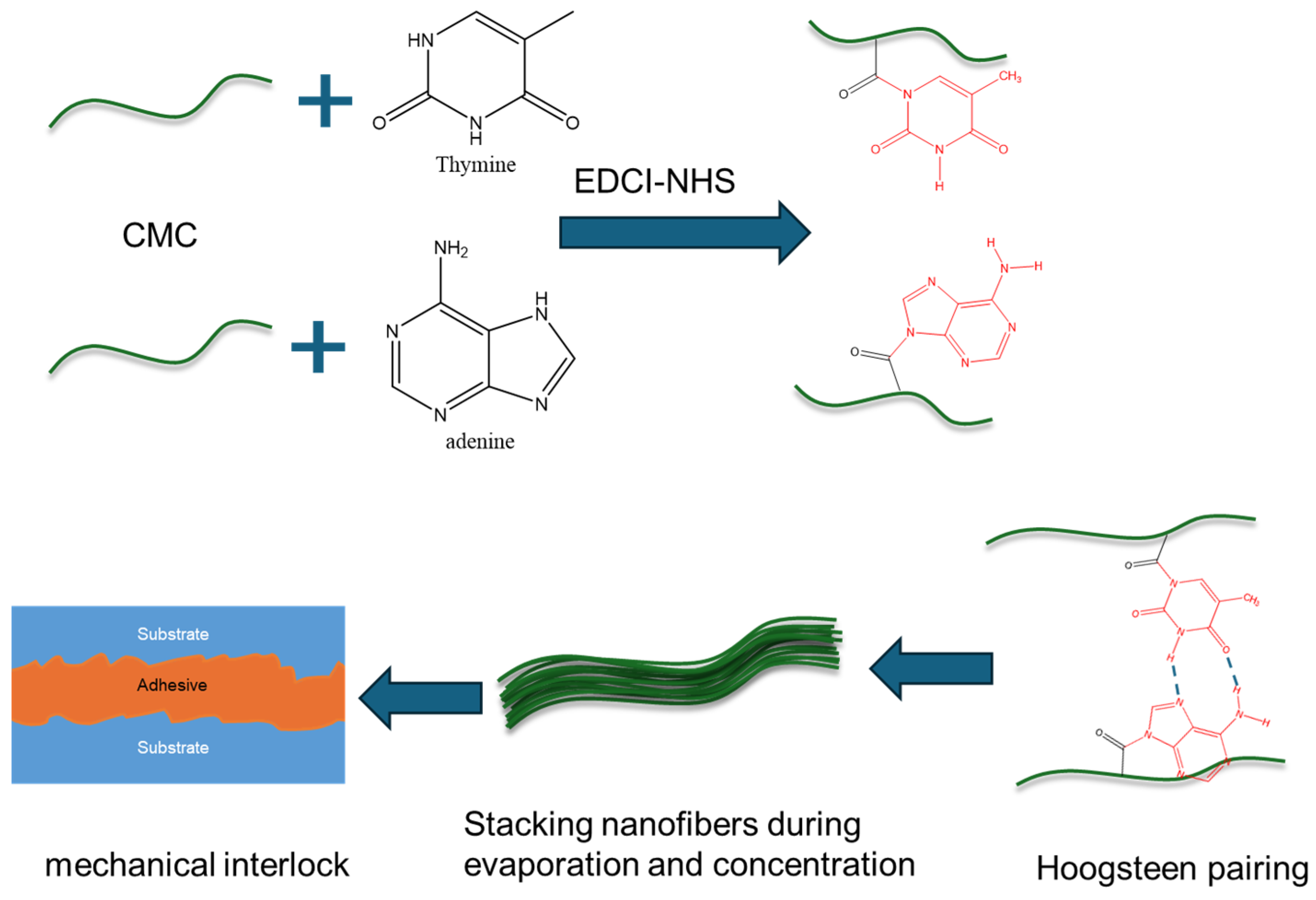
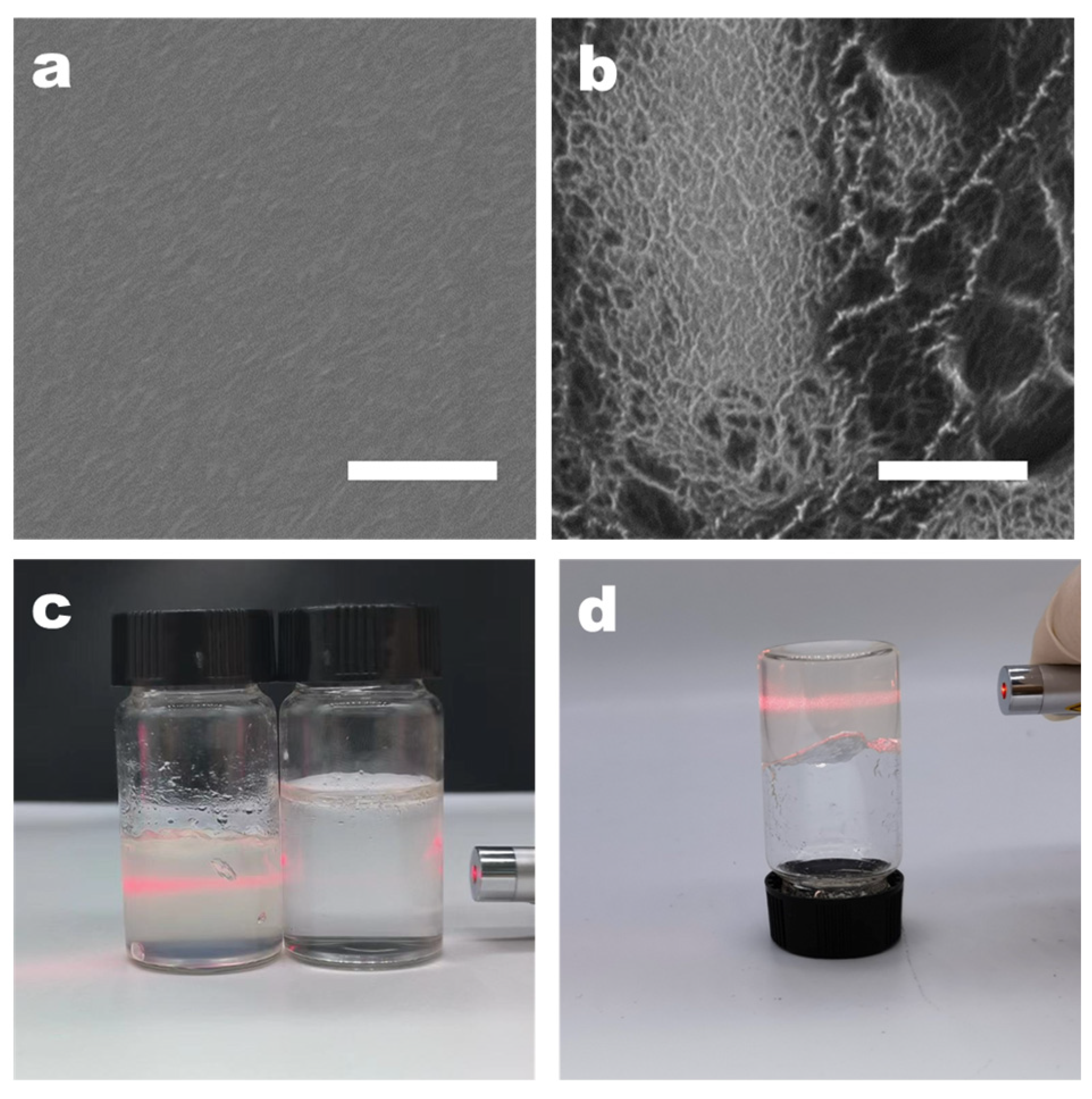
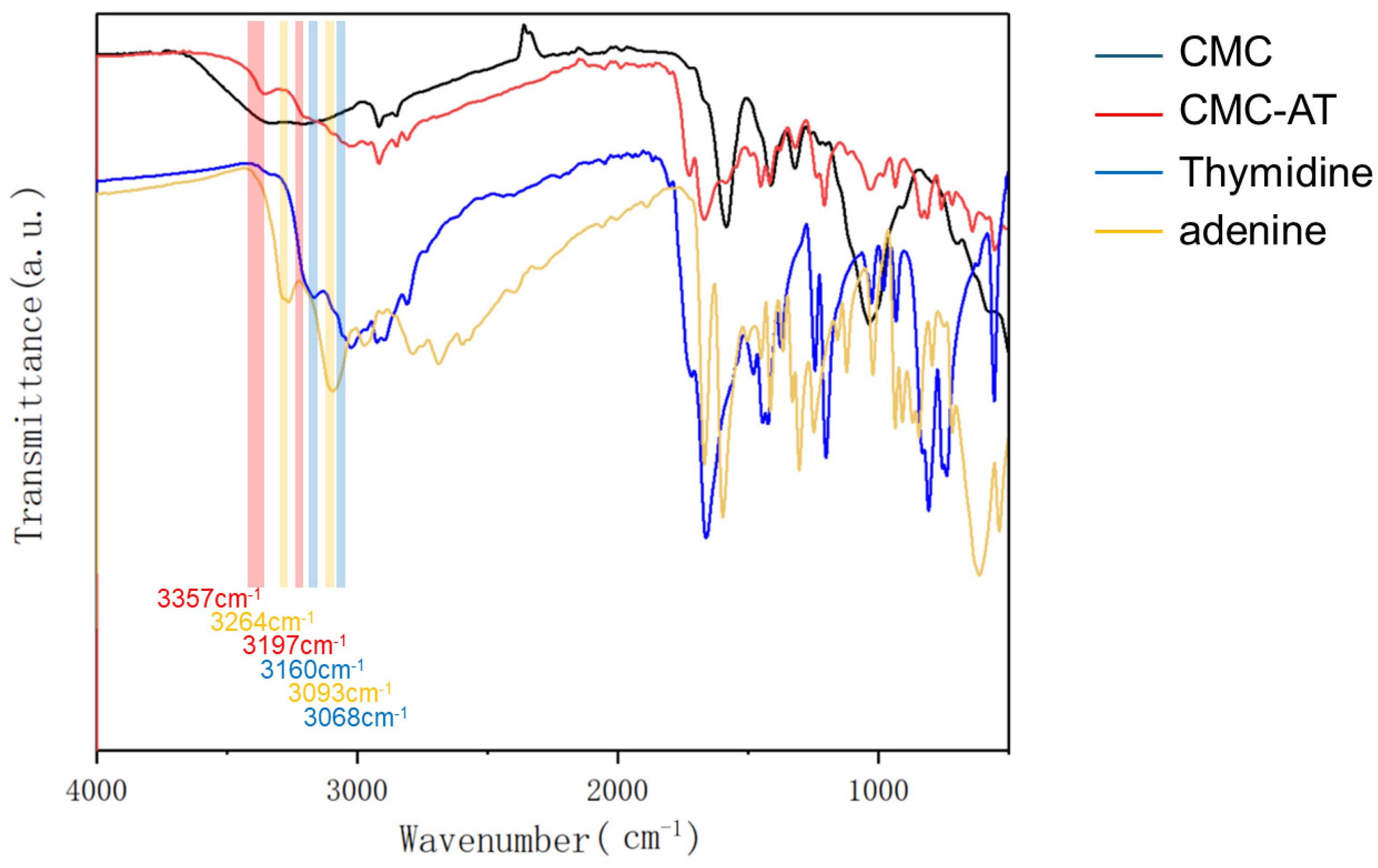
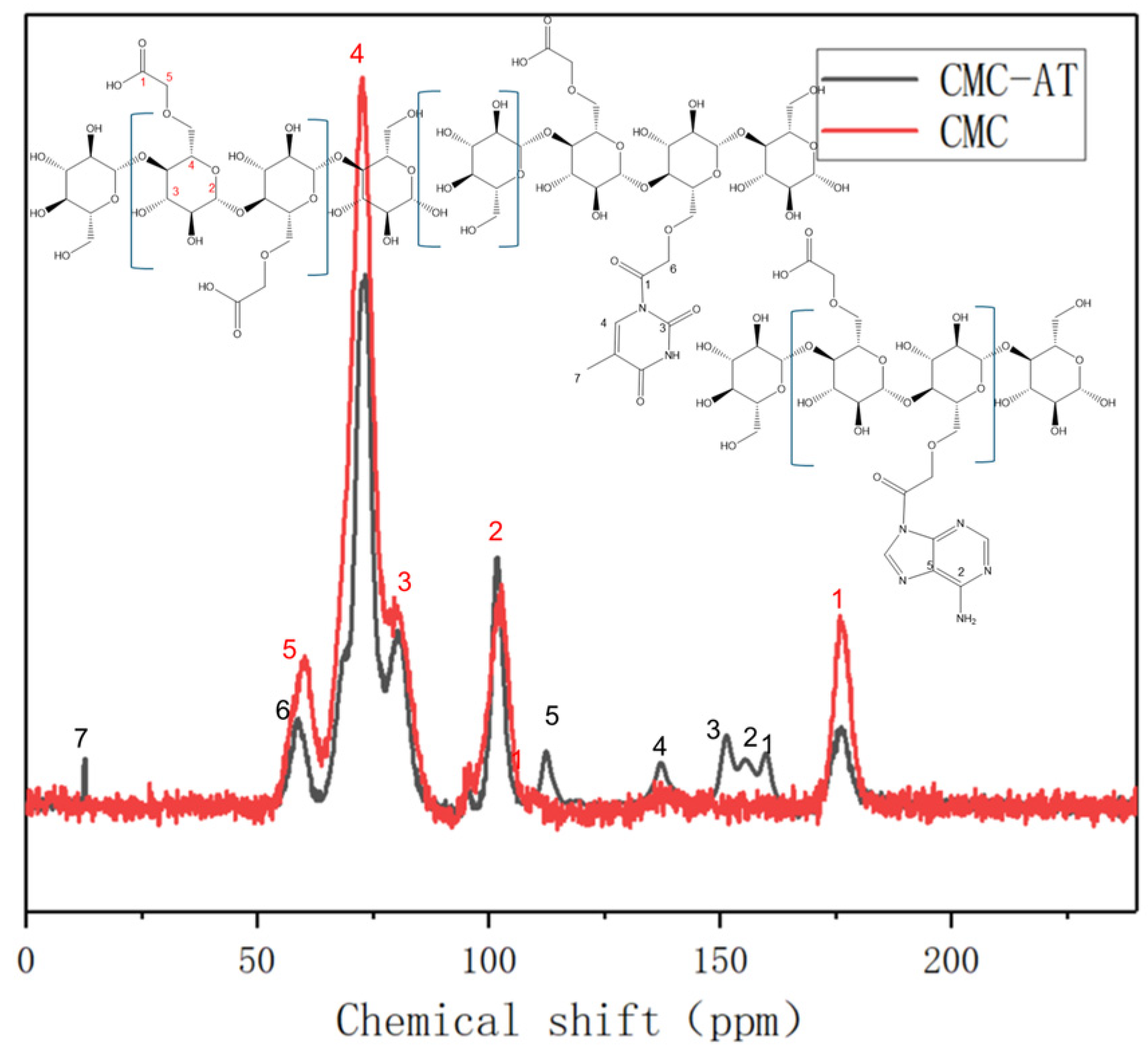

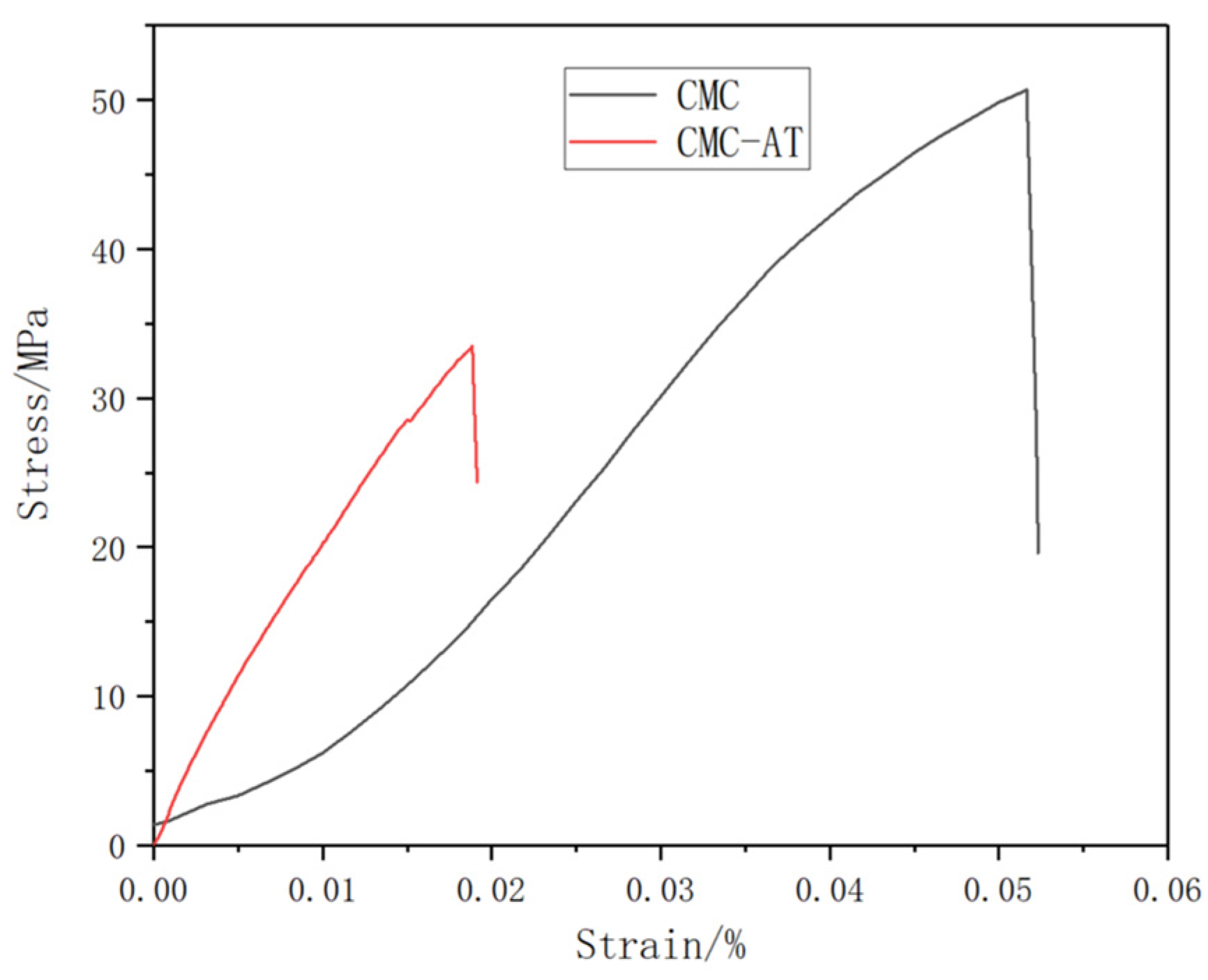
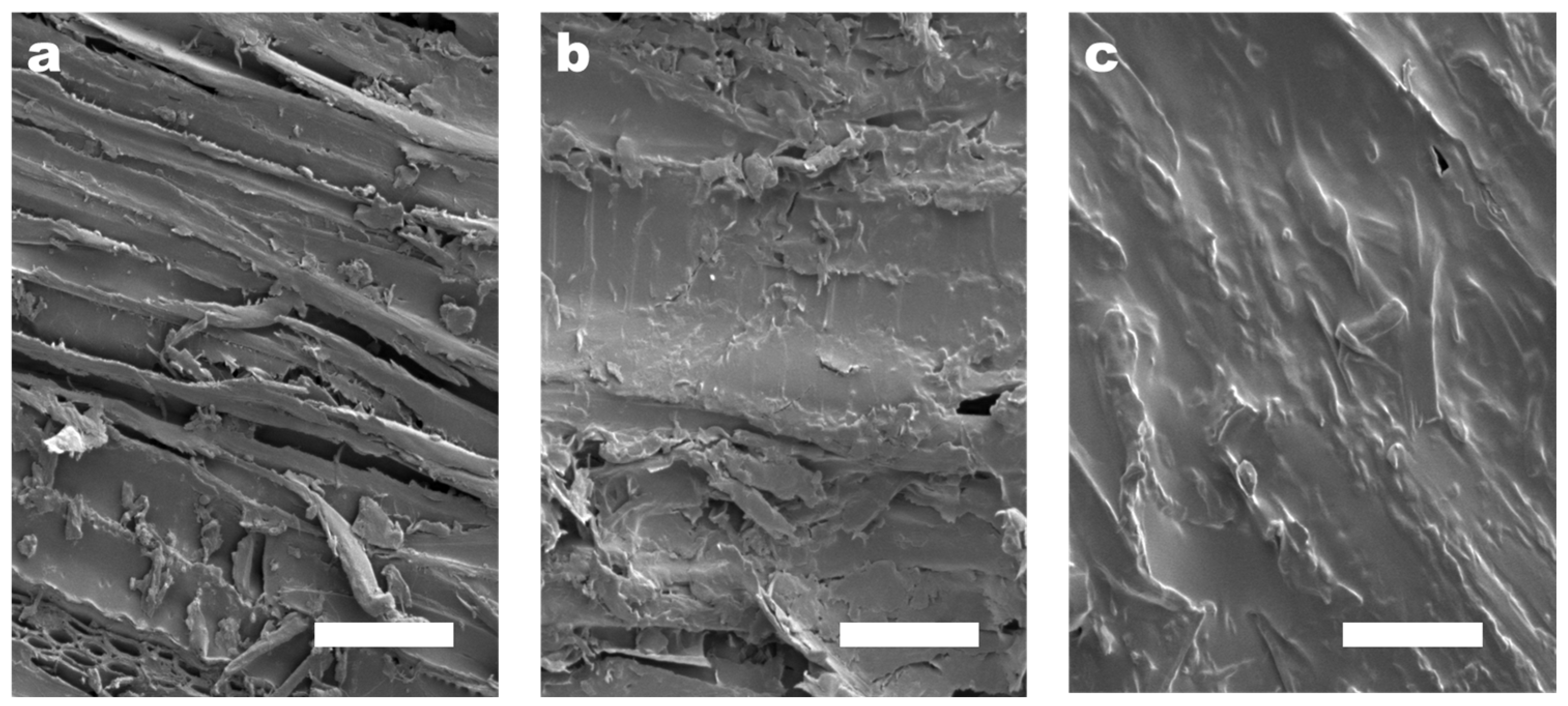
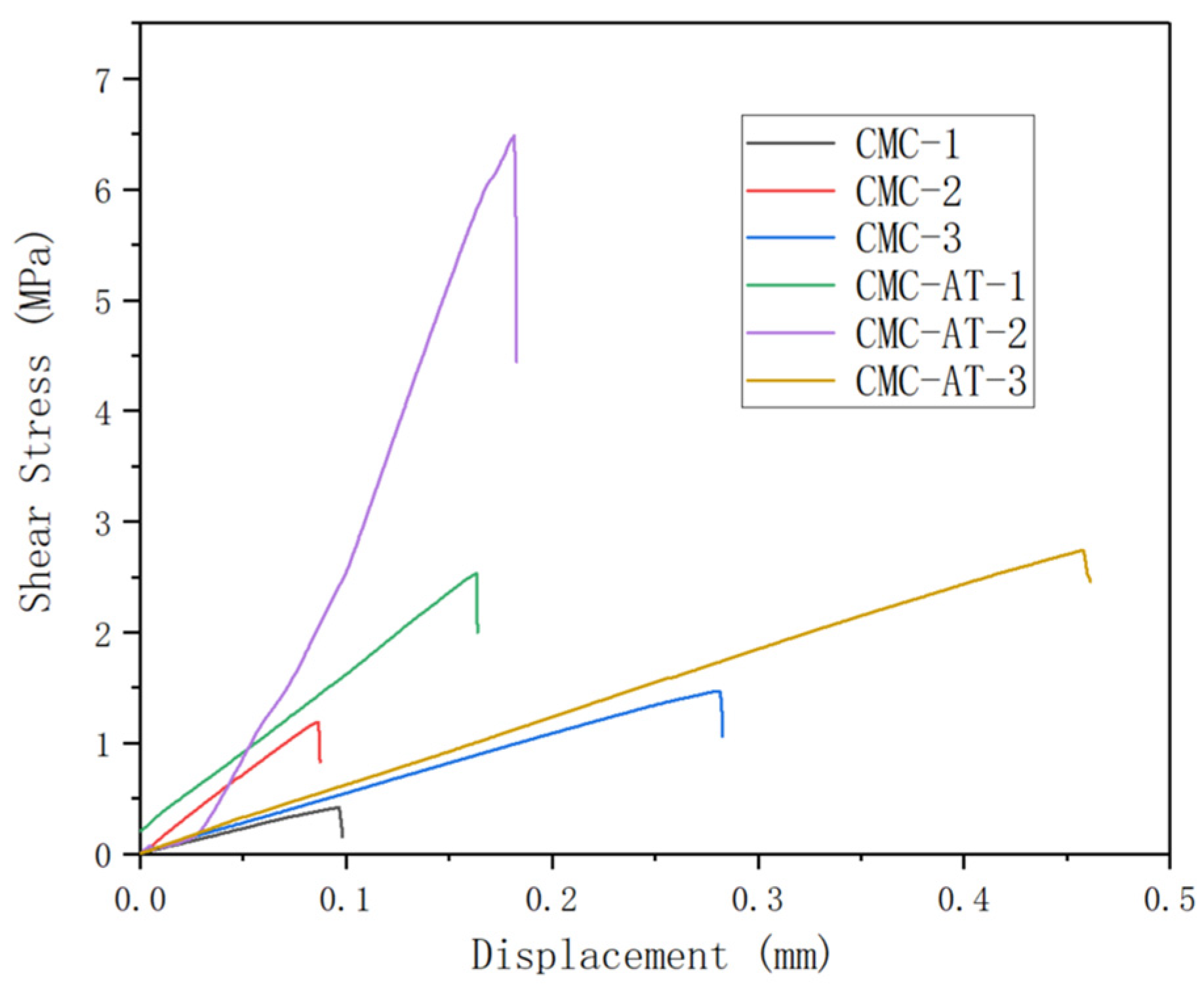
| Sample Names | Adhesive Substrate | Adhesive Dosage |
|---|---|---|
| CMC-1 | basswood | 120 g/m2 |
| CMC-2 | basswood | 360 g/m2 |
| CMC-3 | delignified basswood | 120 g/m2 |
| CMC-AT-1 | basswood | 120 g/m2 |
| CMC-AT-2 | basswood | 360 g/m2 |
| CMC-AT-3 | delignified basswood | 120 g/m2 |
Disclaimer/Publisher’s Note: The statements, opinions and data contained in all publications are solely those of the individual author(s) and contributor(s) and not of MDPI and/or the editor(s). MDPI and/or the editor(s) disclaim responsibility for any injury to people or property resulting from any ideas, methods, instructions or products referred to in the content. |
© 2024 by the authors. Licensee MDPI, Basel, Switzerland. This article is an open access article distributed under the terms and conditions of the Creative Commons Attribution (CC BY) license (https://creativecommons.org/licenses/by/4.0/).
Share and Cite
Xie, C.; Yang, R.; Wan, X.; Li, H.; Ge, L.; Li, X.; Zhao, G. A Novel Nanofiber Hydrogel Adhesive Based on Carboxymethyl Cellulose Modified by Adenine and Thymine. Polymers 2024, 16, 1008. https://doi.org/10.3390/polym16071008
Xie C, Yang R, Wan X, Li H, Ge L, Li X, Zhao G. A Novel Nanofiber Hydrogel Adhesive Based on Carboxymethyl Cellulose Modified by Adenine and Thymine. Polymers. 2024; 16(7):1008. https://doi.org/10.3390/polym16071008
Chicago/Turabian StyleXie, Chong, Runde Yang, Xing Wan, Haorong Li, Liangyao Ge, Xiaofeng Li, and Guanglei Zhao. 2024. "A Novel Nanofiber Hydrogel Adhesive Based on Carboxymethyl Cellulose Modified by Adenine and Thymine" Polymers 16, no. 7: 1008. https://doi.org/10.3390/polym16071008
APA StyleXie, C., Yang, R., Wan, X., Li, H., Ge, L., Li, X., & Zhao, G. (2024). A Novel Nanofiber Hydrogel Adhesive Based on Carboxymethyl Cellulose Modified by Adenine and Thymine. Polymers, 16(7), 1008. https://doi.org/10.3390/polym16071008





